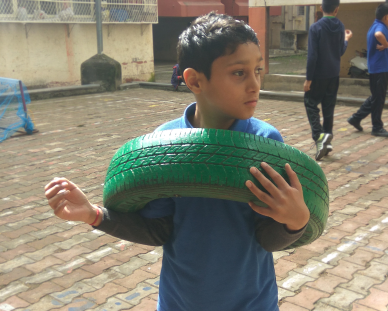Who is it for?
Home » Who is it for?
Is early intervention only for young children?
What are the early indicators to visit an early intervention centre?

An aid to multitude of challenges
With our access to a range of specialists, we are able to attend the following difficulties a child may face.
- Specific Learning Difficulties
- Attention Deficit Hyperactive Disorder
- Autism Spectrum Disorder
- Intellectual Disability
- Cerebral Palsy
- Down Syndrome
- Sensory Processing Disorder
Comprises a diverse group of disorders with the main impairment being cognitive processing which leads to challenges in academic performance and psychosocial implications. This neurodevelopmental disorder brings forth dyslexia (reading challenges), dyscalculia (arithmetical calculation difficulties), dysgraphia (inability to write) and dyspraxia (motor difficulties). According to NIMHANS (India) study, in a school population the prevalence of SLD in written expression was 8-15% and 6% had mathematical difficulties.
Attention deficit hyperactivity disorder (ADHD) is a common neurodevelopmental disorder that usually shows up in early childhood.
Unfortunately, children with undiagnosed or untreated ADHD can struggle with schoolwork, self-esteem, and interpersonal relationships.
Top 14 red flags:
- Impulsive
- Interrupting
- Trouble Taking Turns
- Emotional Turmoil
- Inability to Sit Still
- Problems Playing Quietly
- Problems Finishing Tasks
- Trouble Focusing
- Dislike of Tasks That Require Sustained Mental Effort
- High Prevalence of “Careless Mistakes”
- Daydreaming
- Problems Staying Organized
- Forgetfulness
- Inattentiveness and/or Hyperactivity across Various Settings
Autism spectrum disorder is a condition related to brain development that impacts how a person perceives and socializes with others, causing problems in social interaction and communication. The disorder also includes limited and repetitive patterns of behavior. The term "spectrum" in autism spectrum disorder refers to the wide range of symptoms and severity.
Autism spectrum disorder begins in early childhood and eventually causes problems functioning in society — socially, in school and at work, for example. Often children show symptoms of autism within the first year. A small number of children appear to develop normally in the first year, and then go through a period of regression between 18 and 24 months of age when they develop autism symptoms.
While there is no cure for autism spectrum disorder, intensive, early treatment can make a big difference in the lives of many children.
Social communication and interaction red flags
- Fails to respond to his or her name or appears not to hear you at times
- Resists cuddling and holding, and seems to prefer playing alone, retreating into his or her own world
- Has poor eye contact and lacks facial expression
- Doesn't speak or has delayed speech, or loses previous ability to say words or sentences
- Can't start a conversation or keep one going, or only starts one to make requests or label items
- Speaks with an abnormal tone or rhythm and may use a singsong voice or robot-like speech
- Repeats words or phrases verbatim, but doesn't understand how to use them
- Doesn't appear to understand simple questions or directions
- Doesn't express emotions or feelings and appears unaware of others' feelings
- Doesn't point at or bring objects to share interest
- Inappropriately approaches a social interaction by being passive, aggressive or disruptive
- Has difficulty recognizing nonverbal cues, such as interpreting other people's facial expressions, body postures or tone of voice
Patterns of behavior red flags
- Performs repetitive movements, such as rocking, spinning or hand flapping
- Performs activities that could cause self-harm, such as biting or head-banging
- Develops specific routines or rituals and becomes disturbed at the slightest change
- Has problems with coordination or has odd movement patterns, such as clumsiness or walking on toes, and has odd, stiff or exaggerated body language
Intellectual disability involves problems with general mental abilities that affect functioning in two areas:
- intellectual functioning (such as learning, problem solving, judgement)
- adaptive functioning (activities of daily life such as communication and independent living)
Additionally, the intellectual and adaptive deficity begin early in the developmental period.
There are four levels of ID:
- mild
- moderate
- severe
- profound
ID involves both a low IQ and problems adjusting to everyday life. There may also be learning, speech, social, and physical disabilities.
Red flags
- failure to meet intellectual milestones
- sitting, crawling, or walking later than other children
- problems learning to talk or trouble speaking clearly
- memory problems
- inability to understand the consequences of actions
- inability to think logically
- childish behavior inconsistent with the child’s age
- lack of curiosity
- learning difficulties
- IQ below 70
- inability to lead a fully independent life due to challenges communicating, taking care of themselves, or interacting with others
Behavioral red flags
- aggression
- dependency
- withdrawal from social activities
- attention-seeking behavior
- depression during adolescent and teen years
- lack of impulse control
- passivity
- tendency toward self-injury
- stubbornness
- low self-esteem
- low tolerance for frustration
- psychotic disorders
- difficulty paying attention
Cerebral palsy (CP) is a group of disorders that affect a person’s ability to move and maintain balance and posture. CP is the most common motor disability in childhood. Cerebral means having to do with the brain. Palsy means weakness or problems with using the muscles. CP is caused by abnormal brain development or damage to the developing brain that affects a person’s ability to control his or her muscles.
Movement and coordination red flags
- Stiff muscles and exaggerated reflexes (spasticity), the most common movement disorder
- Variations in muscle tone, such as being either too stiff or too floppy
- Stiff muscles with normal reflexes (rigidity)
- Lack of balance and muscle coordination (ataxia)
- Tremors or jerky involuntary movements
- Slow, writhing movements
- Favoring one side of the body, such as only reaching with one hand or dragging a leg while crawling
- Difficulty walking, such as walking on toes, a crouched gait, a scissors-like gait with knees crossing, a wide gait or an asymmetrical gait
- Difficulty with fine motor skills, such as buttoning clothes or picking up utensils
Speech and eating red flags
- Delays in speech development
- Difficulty speaking
- Difficulty with sucking, chewing or eating
Excessive drooling or problems with swallowing
Development red flags
- Delays in reaching motor skills milestones, such as sitting up or crawling
- Learning difficulties
- Intellectual disabilities
- Delayed growth, resulting in smaller size than would be expected
Other red flags
Damage to the brain can contribute to other neurological problems, such as:
- Seizures (epilepsy)
- Difficulty hearing
- Problems with vision and abnormal eye movements
- Abnormal touch or pain sensations
- Bladder and bowel problems, including constipation and urinary incontinence
- Mental health conditions, such as emotional disorders and behavioral problems
Down syndrome is a genetic disorder caused when abnormal cell division results in an extra full or partial copy of chromosome 21. This extra genetic material causes the developmental changes and physical features of Down syndrome.
Down syndrome varies in severity among individuals, causing lifelong intellectual disability and developmental delays. It's the most common genetic chromosomal disorder and cause of learning disabilities in children. It also commonly causes other medical abnormalities, including heart and gastrointestinal disorders.
Red flags
- Flattened face
- Small head
- Short neck
- Protruding tongue
- Upward slanting eye lids (palpebral fissures)
- Unusually shaped or small ears
- Poor muscle tone
- Broad, short hands with a single crease in the palm
- Relatively short fingers and small hands and feet
- Excessive flexibility
- Tiny white spots on the colored part (iris) of the eye called Brushfield's spots
- Short height
Sensory processing disorder is a neurological condition in children that can affect the way the brain processes information from the senses. People with sensory processing disorder may be extra sensitive to or not react to sensory input, depending on how they are affected.
Examples of sensory input may include:
- light
- sound
- taste
- touch
- smell
Children who have sensory issues may have an aversion to things that overstimulate their senses, such as loud environments, bright lights, or intense smells. Or, they may seek out additional stimulation in settings that don’t stimulate their senses enough.
Sensory processing is typically divided into eight main types. They can include:
- Proprioception. Proprioception is the “internal” sense of awareness you have for your body. It’s what helps you maintain posture and motor control, for example. It also tells you about how you’re moving and occupying space.
- Vestibular. This term refers to the inner ear spatial recognition. It’s what keeps you balanced and coordinated.
- Interoception. This is the sense of what’s happening in your body. It may be best understood as how you “feel.” This includes whether you feel hot or cold and whether you feel your emotions.
- Five senses. Lastly, there are the 5 common senses — touch, hearing, taste, smell, and sight.
The symptoms of having sensory processing issues may depend on the way a child processes different sensations.
Children who are easily stimulated may have hypersensitivity. This means they have an increased sensitivity to sensory inputs like light, sound, and touch. These sensations may bother them more, cause them to lose focus in the presence of too much sensory information, or cause them to act out.
Children may also experience hyposensitivity. This means they may have reduced sensitivity to sensory output.
The type of sensitivity someone experiences may largely determine what their symptoms are. For example, children who are hypersensitive may react as though everything is too loud or too bright. These kids may have difficulty being in noisy rooms. They may also have adverse reactions to smells.
Sensory hypersensitivity may cause:
- a low pain threshold
- appearing clumsy
- fleeing without regard to safety
- covering eyes or ears frequently
- picky food preferences or gagging when eating foods of certain textures
- resisting hugs or sudden touches
- feeling that soft touches are too hard
- difficulty controlling their emotions
- difficulty focusing attention
- difficulty adapting responses
- behavior problems
In contrast, children who are hyposensitive and experience reduced sensitivity crave interaction with the world around them. They may engage more with their surroundings to get more sensory feedback.
In fact, this may make them appear hyperactive, when in reality, they may simply be trying to make their senses more engaged.
Sensory hyposensitivity may cause:
- a high pain threshold
- bumping into walls
- touching things
- putting things into their mouth
- giving bear hugs
- crashing into other people or things
- not regarding personal space
- rocking and swaying


